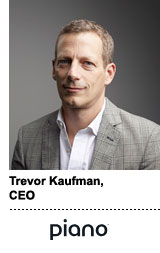
Piano, whose tech and services gives digital publishers a way to supplement their ad revenue, raised $22 million in Series B funding Thursday to expand its offering and help it buy other companies in the space.
“There’s all this ad tech out there, but nothing exists to help publishers treat their traffic as readers and customers,” said Piano CEO Trevor Kaufman.
Piano has tech that handles subscription management, user IDs and email – but its main product, Composer, allows publishers to create rules via a drag-and-drop interface in order show different marketing messages to different audiences.
A publisher could, for instance, show a frequent reader from New York a message to buy a ticket to a local event. Or it could show sports fans a reminder to download a new sports app.
Composer is designed to let marketers decide who sees what messages and when. While publishers can tailor marketing messages today, Kaufman said, it requires working with the IT department, writing code or building an internal tool. These headaches prevent audience development or subscription teams from moving nimbly and testing many ideas quickly.
Piano also provides publisher services to execute on these strategies. About 40% of its clients just use the tech, and 60% use its tech and services. Piano powers Business Insider’s BI Prime, works with Hearst Magazines, Bloomberg, Oath, The Economist and The Ladders, for a total of 1,300 media brands.
It doubled its client base in the past year by adding 50 enterprise clients, many of which run multiple brands.
Publishers pay a software-as-a-service fee to access Piano’s tech, and pay for services with an agency-style billing structure. Kaufman’s background is in agencies – he sold Schematic to WPP in 2007 – so he’s comfortable building out a business that marries tech and services together. Both sides of the business will grow with the new funding.
“We believe that really great software and agency services go hand in hand,” Kaufman said. He wants to “provide them a great car, and ride them around in it.”
Piano also plans to build more detailed reporting for its clients, including benchmarking. Is a 10% conversion rate good or bad? Piano will give publishers a better sense of how they compare.
The funds will also give Piano cash for acquisitions – like publisher tools around editorial data or social media.
Piano’s funding comes as many publishers are launching subscription products, feeling burned by previous efforts to monetize via social platforms. Kaufman sees this as a return to the days of magazine subscriptions and cable networks that relied on carriage fees from cable companies.
“Historically there was some party between the media company and the customer,” Kaufman said. “Editorial brands have always been great B2B marketers, but you don’t tend to think of most of them as great managers of databases of people and DTC marketers. We want to be a repository of best practices for them.”
This post was syndicated from Ad Exchanger.


More Stories
Ibotta Crosses The IPO Finish Line – Now The Real Work Begins
Commerce Can No Longer Be Where Creative Goes to Die
Is This TikTok Ban, Like, Happening?; DTC Darlings Lose Their Retail Darling